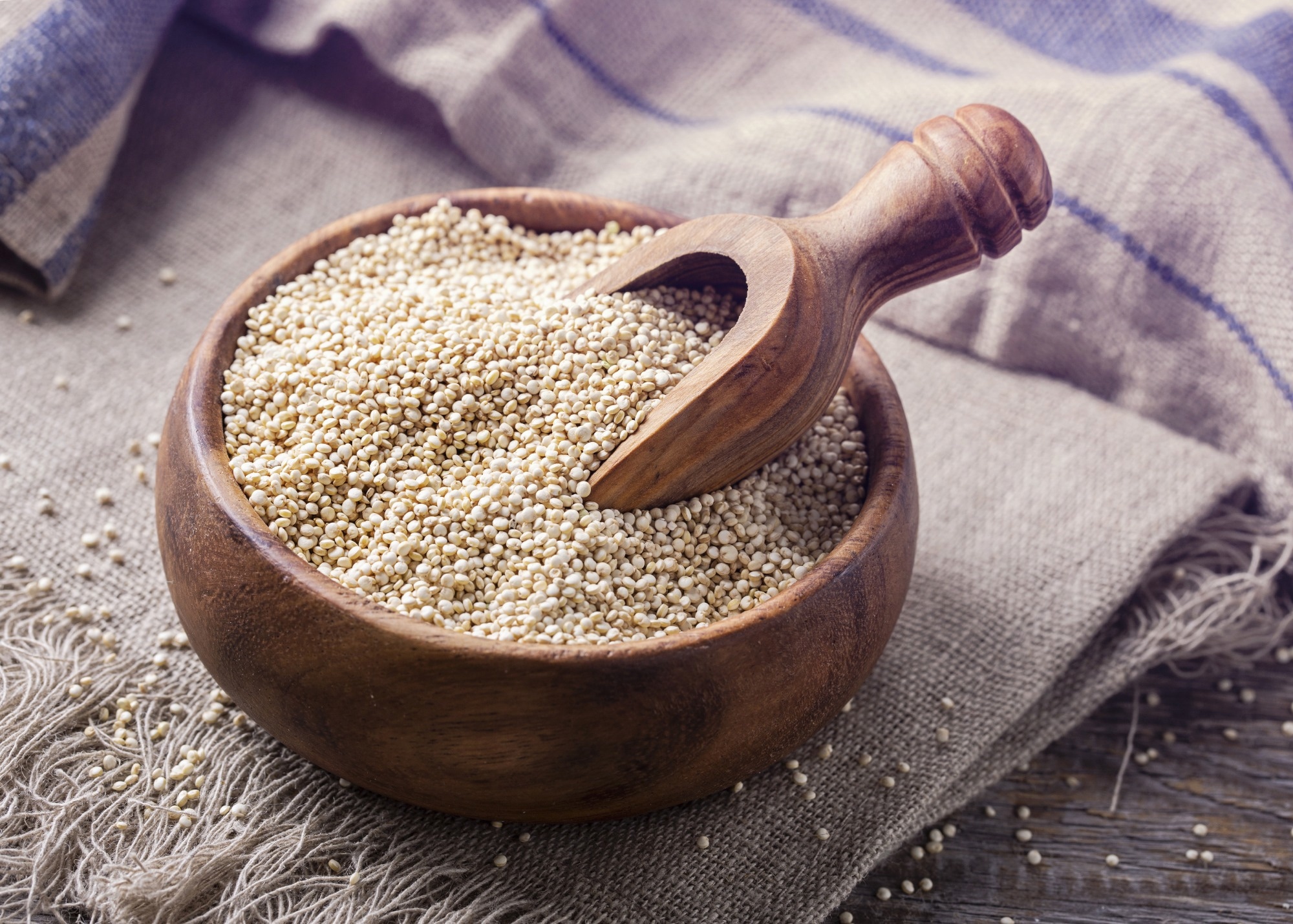In a recent review published in Nutrients, researchers reviewed existing data on the bioactive constituents of quinoa and their health benefits.
 Study: Biotechnological, Nutritional, and Therapeutic Applications of Quinoa (Chenopodium quinoa Willd.) and Its By-Products: A Review of the Past Five-Year Findings. Image Credit: Elena Schweitzer/Shutterstock.com
Study: Biotechnological, Nutritional, and Therapeutic Applications of Quinoa (Chenopodium quinoa Willd.) and Its By-Products: A Review of the Past Five-Year Findings. Image Credit: Elena Schweitzer/Shutterstock.com
Background
Quinoa, also known as Chenopodium quinoa Willd., is a popular super crop since it is winter-hardy, drought-resistant, and easy to grow. Its seeds are ingested as cereal grains and have good nutritional content with vital amino acids, fatty acids, minerals, antioxidants, and vitamins.
Quinoa seeds are gluten-free and have low glycemic values, making them ideal for specific diets and industrial applications. They also possess antiviral, antidepressant, anti-inflammatory, and anticancer effects. Quinoa is appropriate for organic and low-input production methods.
Quinoa is grown in over 123 countries, and its rising consumer interest and consumption are due to increased scientific research. The count of quinoa-related articles has nearly doubled since 2018; however, limited reviews have emphasized quinoa residue value and sustainability.
About the review
In the present review, researchers investigated the nutritional profile and therapeutic properties of quinoa parts and the use of the grain’s biowaste, prioritizing studies published in 2018.
Bioactive constituents of Quinoa
Quinoa is a processed grain high in macronutrients and micronutrients, including folic acid, thiamine, vitamins, and bioactive components such as phenolic compounds, saponins, phytoecdysteroids, phytosterols, peptides, and betalains.
Quinoa has higher lysine, methionine, cysteine, carbohydrate, protein, and fiber content than wheat and rice, as well as higher ash content.
Quinoa also has more riboflavin and folic acid than other grains, including oats, wheat, rye, barley, corn, and rice.
The vitamin content of C. quinoa grain contains ascorbic acid, alpha-tocopherol, beta-tocopherol, gamma-tocopherol, delta-tocopherol, thiamine, riboflavin, and niacin. 100 grams of quinoa seeds has 40% of the daily riboflavin requirement for adults and 80% for children.
Quinoa plant grains are high in fat and thus qualify as an oilseed-type crop. The total content of lipids ranges between 1.4% and 11%, with polyunsaturated and essential fatty acids like linoleic and alpha-linolenic acids being the most common. Total proteins also vary greatly.
Quinoa cookies can help healthy individuals aged 50 to 70 years lose weight and lower circulating low-density lipoprotein (LDL) cholesterol after four weeks of therapy.
These biological activities depend on polyphenols, amino acids, fatty acids, saponins, and fibers.
Potential Benefits of Quinoa for Human Health
Quinoa extracts include significant phenolic components such as quercetin and kaempferol, which have antibacterial and antioxidant effects in vitro.
These chemicals are powerful against bacteria, fungi, and even the fungicide ketoconazole. Quinoa flavonoids, notably quercetin and kaempferol glycosides, are bioavailable and have powerful antioxidant properties against free radicals.
Quinoa saponins have a variety of actions, including anticarcinogenic, hypocholesterolemic, antiviral, immunostimulatory, neuroprotective, antifungal, antiparasitic, and anti-inflammatory properties.
Quinoa triterpenoid saponins may have hypoglycemic effects since they block alpha-glucosidase, increase β-cell activity, and reduce insulin resistance.
The bioactive peptides in quinoa can regulate L6 cell glucose, potentially serving as an antidiabetic drug in spontaneously hypertensive rats.
Furthermore, three fractions of quinoa isolate polysaccharides (QP) exhibit dose-dependent immunoregulatory activity in RAW264.7 cells and antioxidant and antidiabetic activity in vitro. In vivo, quinoa polysaccharides have demonstrated antiaging properties, reversing D-galactose-induced cognitive impairment in male mice.
Administering 800 mg/kg of quinoa over ten weeks can reduce oxidative stress and lipid peroxidation, enhancing organ function and restoring lipid metabolism and sirtuin 1 (SIRT1) pathway regulation in rats.
Quinoa seeds contain antinutritional factors (ANFs), specifically saponins, which can form complexes with cholesterol and other cell membrane components.
Using uncooked quinoa seed flour in human nutrition and feed formulas for monogastric animals raises concerns regarding potential gastrointestinal damage.
Quinoa intake could result in permanent alterations such as food intolerance, a porous gut, and dysbiosis. Quinoa seeds should be thermally processed to reduce the harmful effects since thermally treated grains have significantly reduced emulsification capabilities and flour dispersibility.
Conclusions
To summarize, quinoa phytochemicals, including polyphenols, saponins, peptides, polysaccharides, and dietary fibers, have several nutritional advantages, including antioxidant, antidiabetic, antiaging, antiangiogenic, immunoregulatory, neuroprotective, antihypertensive, hypocholesterolemic, antibacterial, and antifungal properties.
Thus, researchers can use the bioactive compounds in quinoa to develop various medications to lower disease burden.
Quinoa waste has several biotechnological applications, including natural colorants, preservatives, biological therapies, food supplements, foaming agents, antibacterial agents, emulsifiers, and ruminal fungicides.
Its protein isolates have foaming and emulsifying capabilities, while its grain flour, aerial portions, leaves, stalk/stem, and seeds are food components and industrial compounds.